Antibody data
- Antibody Data
- Antigen structure
- References [6]
- Comments [0]
- Validations
- Immunohistochemistry [5]
- Other assay [2]
Submit
Validation data
Reference
Comment
Report error
- Product number
- OPA1-15619 - Provider product page

- Provider
- Invitrogen Antibodies
- Product name
- GRPR Polyclonal Antibody
- Antibody type
- Polyclonal
- Antigen
- Synthetic peptide
- Description
- Recommended positive controls: Human pancreas, islets of Langerhans. By immunohistochemistry, OPA1-15619 detects GRPR in formalin fixed, paraffin embedded human tissues.
- Reactivity
- Human, Canine, Porcine, Rabbit
- Host
- Rabbit
- Isotype
- IgG
- Vial size
- 25 μg
- Concentration
- 1 mg/mL
- Storage
- Store at 4°C short term. For long term storage, store at -20°C, avoiding freeze/thaw cycles.
Submitted references Gastrin-releasing peptide receptor expression in lung cancer.
Expression of gastrin-releasing peptide receptor in patients with cutaneous malignant melanoma.
BDNF/TrkB content and interaction with gastrin-releasing peptide receptor blockade in colorectal cancer.
BDNF and PDE4, but not the GRPR, regulate viability of human medulloblastoma cells.
Stimulation of proliferation of U138-MG glioblastoma cells by gastrin-releasing peptide in combination with agents that enhance cAMP signaling.
Gastrin-releasing peptide receptors regulate proliferation of C6 Glioma cells through a phosphatidylinositol 3-kinase-dependent mechanism.
Mattei J, Achcar RD, Cano CH, Macedo BR, Meurer L, Batlle BS, Groshong SD, Kulczynski JM, Roesler R, Dal Lago L, Brunetto AT, Schwartsmann G
Archives of pathology & laboratory medicine 2014 Jan;138(1):98-104
Archives of pathology & laboratory medicine 2014 Jan;138(1):98-104
Expression of gastrin-releasing peptide receptor in patients with cutaneous malignant melanoma.
Marrone BF, Meurer L, Moretto A, Kleina W, Schwartsmann G
Clinical and experimental dermatology 2013 Oct;38(7):707-12
Clinical and experimental dermatology 2013 Oct;38(7):707-12
BDNF/TrkB content and interaction with gastrin-releasing peptide receptor blockade in colorectal cancer.
Brunetto de Farias C, Rosemberg DB, Heinen TE, Koehler-Santos P, Abujamra AL, Kapczinski F, Brunetto AL, Ashton-Prolla P, Meurer L, Reis Bogo M, Damin DC, Schwartsmann G, Roesler R
Oncology 2010;79(5-6):430-9
Oncology 2010;79(5-6):430-9
BDNF and PDE4, but not the GRPR, regulate viability of human medulloblastoma cells.
Schmidt AL, de Farias CB, Abujamra AL, Kapczinski F, Schwartsmann G, Brunetto AL, Roesler R
Journal of molecular neuroscience : MN 2010 Mar;40(3):303-10
Journal of molecular neuroscience : MN 2010 Mar;40(3):303-10
Stimulation of proliferation of U138-MG glioblastoma cells by gastrin-releasing peptide in combination with agents that enhance cAMP signaling.
Farias CB, Lima RC, Lima LO, Flores DG, Meurer L, Brunetto AL, Schwartsmann G, Roesler R
Oncology 2008;75(1-2):27-31
Oncology 2008;75(1-2):27-31
Gastrin-releasing peptide receptors regulate proliferation of C6 Glioma cells through a phosphatidylinositol 3-kinase-dependent mechanism.
Flores DG, de Farias CB, Leites J, de Oliveira MS, Lima RC, Tamajusuku AS, Di Leone LP, Meurer L, Brunetto AL, Schwartsmann G, Lenz G, Roesler R
Current neurovascular research 2008 May;5(2):99-105
Current neurovascular research 2008 May;5(2):99-105
No comments: Submit comment
Supportive validation
- Submitted by
- Invitrogen Antibodies (provider)
- Main image
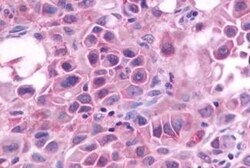
- Experimental details
- Immunohistochemical (Paraffin) analysis of human skin, melanoma tissue using (Product # OPA1-15619) GRPR Polyclonal Antibody. Antigen retrieval: Heat-induced antigen retrieval.
- Submitted by
- Invitrogen Antibodies (provider)
- Main image
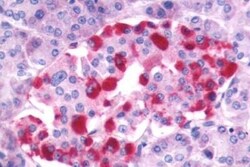
- Experimental details
- Immunohistochemical (Paraffin) analysis of human pancreas, islet of langerhans tissue using (Product # OPA1-15619) GRPR Polyclonal Antibody. Antigen retrieval: Heat-induced antigen retrieval.
- Submitted by
- Invitrogen Antibodies (provider)
- Main image
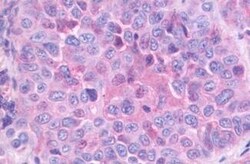
- Experimental details
- Immunohistochemical (Paraffin) analysis of human lung, non-small cell carcinoma tissue using (Product # OPA1-15619) GRPR Polyclonal Antibody. Antigen retrieval: Heat-induced antigen retrieval.
- Submitted by
- Invitrogen Antibodies (provider)
- Main image
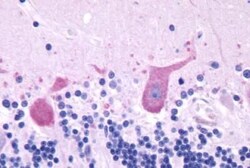
- Experimental details
- Immunohistochemical (Paraffin) analysis of brain cerebellum purkinje neurons tissue using (Product # OPA1-15619) GRPR Polyclonal Antibody.
- Submitted by
- Invitrogen Antibodies (provider)
- Main image
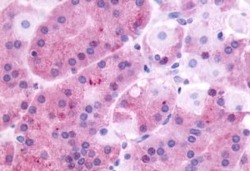
- Experimental details
- Immunohistochemical (Paraffin) analysis of stomach tissue using (Product # OPA1-15619) GRPR Polyclonal Antibody.
Supportive validation
- Submitted by
- Invitrogen Antibodies (provider)
- Main image

- Experimental details
- Antibody staining in gastrin-releasing peptide receptor (GRPR)-positive melanoma tissues. (a,b) GRPR immunoexpression in melanoma, showing strong positive staining. Original magnification (a) x100; (b) x400.
- Submitted by
- Invitrogen Antibodies (provider)
- Main image

- Experimental details
- Antibody staining in gastrin-releasing peptide receptor (GRPR)-negative melanoma tissue. Original magnification (a) x200.
 Explore
Explore Validate
Validate Learn
Learn Western blot
Western blot Immunohistochemistry
Immunohistochemistry